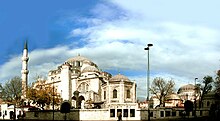Şehzade Mosque
| Şehzade Mosque | |
|---|---|
 Şehzade Mosque | |
| Religion | |
| Affiliation | Islam |
| Location | |
| Location | Istanbul, Turkey |
| Architecture | |
| Architect(s) | Mimar Sinan |
| Type | mosque |
| Groundbreaking | 1543 |
| Completed | 1548 |
| Specifications | |
| Dome height (outer) | Template:M to ft |
| Dome dia. (inner) | Template:M to ft |
| Minaret(s) | 2 |
| Materials | granite, marble |
The Şehzade Mosque ([Şehzade Camii] Error: {{Lang-xx}}: text has italic markup (help)) is an Ottoman imperial mosque located on the third hill of Istanbul, Turkey. It is sometimes referred to as the “Prince's Mosque” in English[1]
History
The Şehzade Mosque was commissioned by Sultan Suleiman I in memory of his eldest son, Prince Mehmet, who died of smallpox at the age of 21 in 1543, though the cause for his death is disputed. It was the first major commission by the Imperial Architect Mimar Sinan, and was completed in 1548. It is considered by architectural historians as Sinan's first masterpiece of classical Ottoman architecture.
Architecture
Exterior
The mosque is surrounded by an inner colonnaded courtyard (avlu) with an area equal to that of the mosque itself. The courtyard is bordered by a portico with five domed bays on each side, with arches in alternating pink and white marble. At the center is an ablution fountain (sadirvan), which was a later donation from Sultan Murat IV. The two minarets have elaborate geometric sculpture in low bas-relief and occasional terracotta inlays.
The mosque itself has a square plan, covered by a central dome, flanked by four half-domes. The dome is supported by four piers, and has a diameter of 19 meters and it is 37 meters high. It was in this building that Sinan first adopted the technique of placing colonnaded galleries along the entire length of the north and south facades in order to conceal the buttresses.

Interior
The interior of the Şehzade Mosque has a symmetrical plan, with the area under the central dome expanded by use of four semidomes, one on each side, in the shape of a four leaf clover. This technique was not entirely successful, as it isolated the four huge piers needed to support the central dome, and was never again repeated by Sinan. The interior of the mosque has a very simple design, without galleries.

The Complex
Şehzade complex (Külliye) is situated between Fatih and Bayezid complexes. The Külliye consists of the mosque, the (turbe) of Prince Mehmet (which was completed prior to the mosque), two Qur'an schools (medrese), a public kitchen (imaret) which served food to the poor, and a caravansarai. The mosque and its courtyard are surrounded by a wall that separates them from the rest of the complex.
The Şehzade Turbe
The imperial mausoleums are noted for their lavish use of İznik tiles. The first and largest is that turbe of Şehzade Mehmet, an octagonal structure, with polychrome stonework and terracotta window frames and arches and an opus sectile porch. The double dome is fluted. An inscription in Persian verse over the door gives the date of the Prince's death and suggests that the interior of the turbe is like a garden in Paradise. The interior is covered in extremely rare apple-green and lemon-yellow Iznik tiles from floor to top of the interior dome, and the windows have stained glass. A curious feature of the turbe is a walnut baldachino over the tomb itself. Within the turbe are also the tombs of Mehmet's daughter Humusah Sultan and his brother Cihangir.
To the left and behind the Şehzade Turbe is the Turbe of Grand Vizier Rüstem Pasha, also by Sinan. Rüstem Pasha was the son-in-law of Suleiman the Magnificent. As at the Rüstem Pasha Mosque, an overwhelming quantity of Iznik tiles was used. By the gate to the complex is the Turbe of Grand Vizier Ibraham Pasha, son-in-law of Murat III, who died in 1601. The turbe was designed by Dalgic Ahmed Cavus, and almost equals that of Şehzade Turbe in design and use of tiled decoration.
References
- ^ Rogers, Sinan, pp. index
- Aptullah Kuran: Sinan: The grand old master of Ottoman architecture, Ada Press Publishers, 1987. ISBN 0-941469-00-X (in English)
- Denny, Walter B. (2005). Iznik: The Artistry of Ottoman Ceramics. Thames & Hudson. ISBN 0500511926.
- Faroqhi, Suraiyah (2005). Subjects of the Sultan: Culture and Daily Life in the Ottoman Empire. I B Tauris. ISBN 1850437602.
- Freely, John (2000). Blue Guide Istanbul. W. W. Norton & Company. ISBN 0393320146.
- Rogers, J.M. (2007). Sinan: Makers of Islamic Civilization. I B Tauris. ISBN 184511096X.



